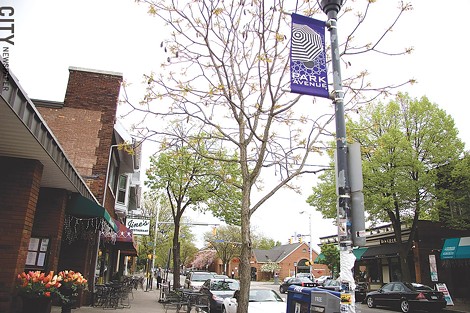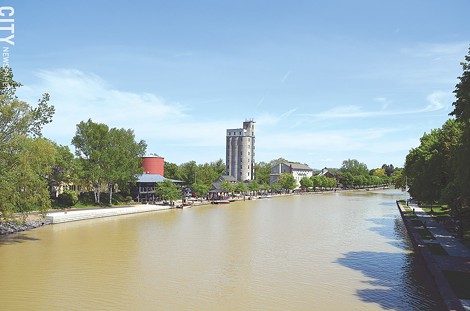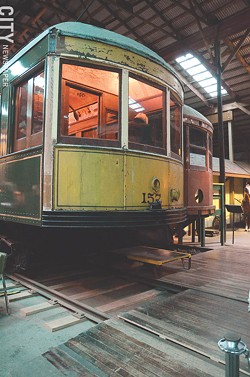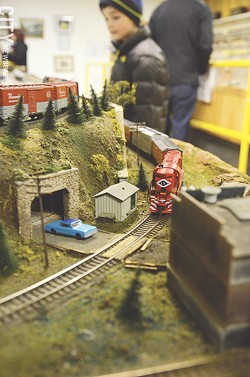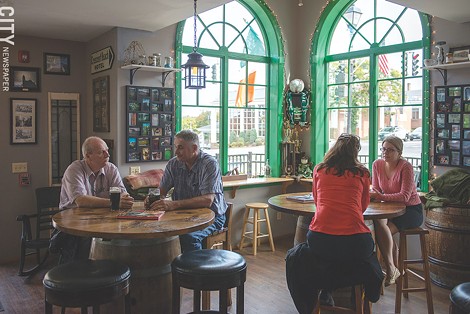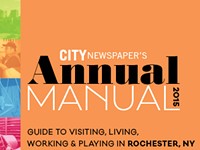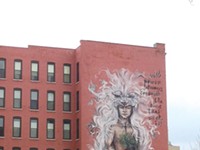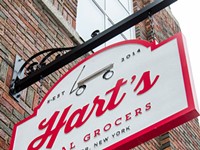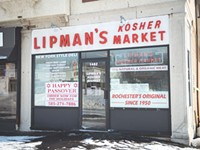Know your neighborhoods
Swillburg, Park Avenue, Thurston Village, Village of Pittsford, Village of Webster, Town of Rush
By JEREMY MOULE AND CHRISTINE CARRIE FIEN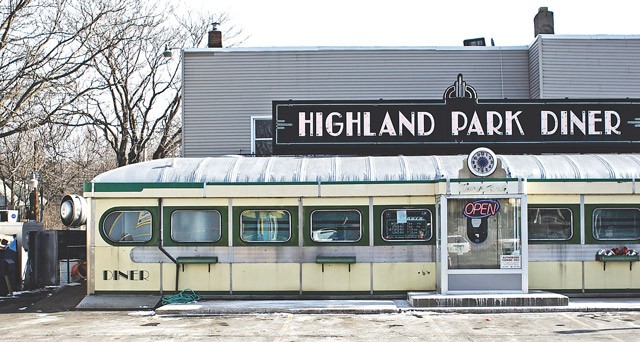
The Highland Park Diner in Swillburg. The neighborhood has one of the highest rates of owner occupancy in the city.
[
{
"name": "500x250 Ad",
"insertPoint": "5",
"component": "15667920",
"parentWrapperClass": "",
"requiredCountToDisplay": "1"
}
]
Swillburg
The word in Swillburg is that when you go out of town, you have 20 sets of eyes watching your home.
Swillburg comes about its neighborliness organically: it's a relatively small neighborhood, and the homes tend to be close together and close to the street. "I think that's kind of created a hamlet-like atmosphere in our neighborhood," says Josh Massicot, a Swillburg homeowner who spearheaded the revitalization of the Swillburg Neighborhood Association. "Just within eyeshot of our house, I call 10 households our good friends."
Most of the homes in this Southeast neighborhood are between 80 and 90 years old, he says, and Swillburg has one of the highest rates of owner occupancy in the city.
The 20-block neighborhood has Field Street, South Clinton, Meigs Street, and Interstate 490 as its borders.
Swillburg is an up-and-coming neighborhood, Massicot says, with some of the city's most iconic small businesses, including the Highland Diner and the Cinema Theatre. Many of the services that residents want or need — restaurants, bakery, theater, coffee shops — are in walking distance.
The area was once used to farm pigs, which is how the neighborhood got its name. Local legend, according to the city's website, says that swill for the pigs was collected alongside the Erie Canal, which used to run through the city.
A point of pride for Swillburg neighbors is Otto Henderberg Park, named for the man who led a grassroots campaign to stop an expressway from cutting up the neighborhood. The campaign was successful, but not before a block of homes was demolished.
Some of the land was turned into the park, which has sycamore trees, a gazebo, and a plaque commemorating bandleader Cab Calloway, who once lived in Swillburg. Neighbors do tai chi and yoga in the park in the summer, and the association has a neighborhood potluck there each June.
"It's one of those little pocket parks that you would never know if you didn't live in Swillburg," Massicot says. "But it's a beautiful place."
Swillburg also has a fair amount of green space and gardens. The Labyrinth Garden across from Rooney's Restaurant on Henrietta Street has more than 300 varieties of flowers, Massicot says, and a brick path winds through it. There's also a community vegetable garden.
But it's the sense of community that makes the neighborhood what it is, Massicot says.
"It's really corny, but it's just kind of the reality of living here," he says. "We just genuinely look forward to seeing each other, and that's a pretty cool thing."
Park Avenue
Park Avenue's appeal never gets old. For years it has been the epicenter of hip in Rochester, the place to see and be seen.
And if you want to live in the Park area, you'd better move fast; the neighborhood's desirably means that houses and apartments don't stay on the market long — sometimes only a matter of weeks.
But Park's origins are much more modest; it was built as a service street for the people living in the mansions on East Avenue, says Jimmy Catalano, who's involved with several organizations in the Park Avenue area, including the Park Avenue Neighborhood Coalition.
The storefronts in this Southeast neighborhood were once hardware stores, liquor stores, laundry, groceries, and florists servicing the East Avenue elite, he says. And you can see those blue-collar roots in the more modest homes near Alexander Street, he said.
As the years passed, some of the people who wanted to be close to the East aesthetic but couldn't afford it began making their homes in the neighborhood.
"We had the wealthy but not-as-wealthy that started building here," Catalano says. "You know, people who had money but not the money that the mansion dwellers had."
But Park Avenue also has grander homes in a variety of architectural styles — several designed by noted Rochester architect Claude Bragdon.
"Westminster Road has some gorgeous homes on it," Catalano says, "as does Barrington Street. You get down to the Argyle, Buckingham, Brunswick section, too, you've got 4,000-square-foot homes with huge columns and sweeping staircases and stained-glass windows."
Some people found the larger homes to be unsustainable financially, he says, so many homes were cut up into apartments.
"We've got a ton of homes here that are three- and four-family homes," Catalano says.
Walkability is a big selling point for the neighborhood, which is a good thing because finding street parking can be a challenge.
"You've got everything at your fingertips: clubs, pubs, restaurants," Catalano says.
The Park neighborhood has several businesses known and patronized by people both inside and outside the city, including Jines Restaurant, Stever's Candy, Parkleigh gift shop, Park Avenue Pub, the Frog Pond, and Hogan's Hideaway.
The neighborhood also has the popular Park Avenue festival each summer.
Walkability tends to encourage sociability, and many Park neighbors aren't shy about stopping by. Catalano says that when he hangs out on his porch, it's not uncommon to have four or five neighbors pop over for a visit.
"We're such a melting pot of a neighborhood," he says. "There are all sorts of ages, shapes, colors, orientations. You name it, it's in this neighborhood. And everybody gets along, for the most part, which is really what adds to the charm."
Thurston Village
Neighborhood loyalty runs thick and deep in the 19th Ward, says John DeMott, a street manager with the Sector 4 Community Development Corporation. Even when people move away, he says, they often keep patronizing the ward's businesses and attending its churches.
"It's kind of a feeling," DeMott says. "Once you're a 19th Ward person, you're always a 19th Ward person."
That affection is captured on T-shirts commemorating the 19th Ward Community Association's 50th anniversary this year. Featured on the front of the shirt is an image of Louie's Sweet Shop, an iconic 19th Ward business. On the back it says, "I'm a 19th Ward kid."
"All our kids moved out of the immediate neighborhood," DeMott says. "But they all went nuts when they got that shirt for Christmas."
Louie's was at the corner of Brooks Avenue and Thurston Road for more than 70 years. The spot is now occupied by Holly's Café & Catering, but the Louie's name lives on at a snack shop at The Strong museum.
Thurston Road seems an appropriate location for a business like Louie's that people recall with so much affection; DeMott says that Thurston in Southwest Rochester is the heart of the 19th Ward.
"The whole 19th Ward community surrounds Thurston Road," he says. "The 19th Ward is really the residential area and we just nicknamed the commercial district Thurston Village just to give it an identity. And it seems to have stuck."
The Village runs north to south from Ravenwood Avenue to Brooks Avenue. Hunt's Hardware celebrated its 100th anniversary last year, and there's a post office, restaurants, bars, "everything you'd want in a small village," DeMott says.
"I think of it as an area that caters to those of us who live there, as opposed to being a destination," he says. "Our restaurants aren't fancy, our stores aren't fancy, but we enjoy shopping in our own neighborhood. I can walk to probably a half-dozen places to eat from my home. They're not fancy places, but it's good food, good people."
Thurston Village has been undergoing a revitalization project for several years. The City of Rochester has been making improvements to lighting, signs, gateway features, and other aspects to enhance the urban village feel of the corridor.
And 19 storefronts have gotten grants over the last few years to spruce up their facades, DeMott says.
The surrounding neighborhood has a broad range of incomes, he says, including many residents who are associated with the University of Rochester or Strong Hospital, and it has a mix of incomes, races, backgrounds, and ages.
And several community organizations and the City of Rochester put on a fledgling spring festival called "Ease on Down Thurston Road" with food, music, prizes, and sidewalk sales.
"It's humble," DeMott says. "We're not going to eclipse the Corn Hill festival or the Park Avenue thing. But it is kind of a fun thing."
Village of Pittsford
Pittsford is Monroe County's oldest village, and the community has worked to keep its connection to the past. The village was established in 1827, and its early growth was driven by the Erie Canal, which flows just north of Pittsford's downtown.
Schoen Place, which was once an alley lined with mills, lumberyards, and warehouses, is now a popular waterfront area. The village built a docks and a promenade along the canal and the old buildings have been converted into shops, restaurants, salons, and offices. A silo, the tallest structure in the village, has been renovated for office space.
For the past few decades, preservation has been a major focus in the compact village of approximately 1,500, which is designated as a local and national historic district. And Pittsford has laws in place to help ensure that structures — residential and commercial — keep their historic look and feel.
Many of the stores, restaurants, and offices along South Main Street are in brick buildings dating back to the 1800's. The buildings are well-cared for and in some cases, have been restored.
The Phoenix Hotel at the Village's Four Corners, once a busy stagecoach stop, was damaged by fire in the 1950's, but was bought and restored by a local newspaper publisher. It's a prized example of Federal-style architecture in the village.
The village also has a visible reminder of its agricultural past: Pittsford Farms Dairy. The 200-acre property is permanently protected as farmland, and it's still a working dairy processor. It distributes milk in glass bottles and is a popular stop for people to pick up ice cream and baked goods.
Village of Webster
The Erie Canal gets a lot of the credit for spurring the development of hamlets, villages, and cities in New York. But many communities grew along other key trade and travel corridors, such as railroads and, in the western part of the state, Ridge Road.
The Village of Webster got its start as a stagecoach stop, and later emerged as a key commercial hub between ports on the Erie Canal and Lake Ontario. It was especially important for the area's farmers, as was the village's substantial canning industry.
All of that early business activity gave the village one of its enduring and defining features: a solid downtown, centered at Ridge Road and State Route 250. The village center includes bars and restaurants, salons, and a shoe-repair business.
The village's downtown is also filled with independent businesses, which provide a stark contrast to the plazas filled with big-box stores in the Town of Webster. Among the downtown stores are hobby, bridal, bike, arts, and music shops as well as specialized boutiques.
In the warmer months, the Village of Webster Business Improvement District holds several events and concerts, including the annual Webster Jazz Festival, which is on July 25 this year.
The village is also home to the Xerox campus; Webster annexed more than 180 acres back in the 1950's for the company. Once the region's second-largest employer but now its fourth largest, Xerox has its research center in the village, as well as a toner plant and several other operations.
Town of Rush
Rush is Monroe County's southernmost town, and one of Rochester's most rural suburbs.
Rush has a population of 3,478 people, spread across 30.6 square miles. About 28 percent of the town's land is residential, but the largest sector — approximately 38 percent — is agricultural, which includes a whitetail deer-breeding operation.
Rush is an interesting place with unique offerings, such as the New York Museum of Transportation and the Genesee Valley Railroad Museum, both at 6393 East River Road. Visitors pay one price to enter both museums.
The Transportation Museum's collection includes some of the area's old trolley cars, horse-drawn vehicles, and various other historical vehicles. It also has a color film of the Rochester subway. The Railroad Museum has a variety of rail cars.
The Rush Town Hall at 5977 East Henrietta Road was a Works Progress Administration project finished in 1996. It has since been renovated and expanded.
And the town is also home to the Rush Oak Openings, the only intact oak savanna in New York, and the easternmost oak savanna in the country, according to the Nature Conservancy of Central and Western New York. The oak openings or savanna — the terms are used interchangeably — are grassy areas with a low density of oak trees.
Some of the land is privately owned, but the state and the Nature Conservancy own large chunks, too, and their properties are open to the public. The savanna is located near the intersection of West Henrietta Road and Honeoye Falls-Five Points Road.
In This Guide...
Latest in Annual Manual
More by JEREMY MOULE AND CHRISTINE CARRIE FIEN
-

Anthony Costello dies
Mar 14, 2016 -

The impossible woman
Aug 5, 2015 - More »
